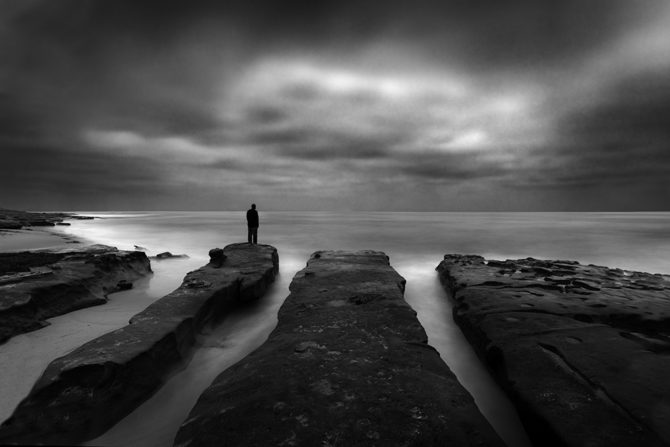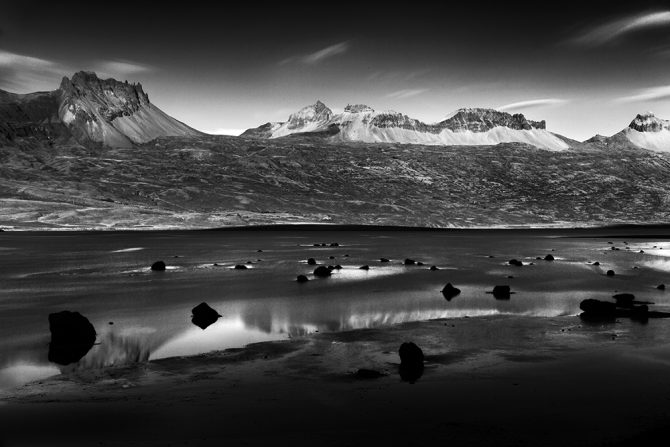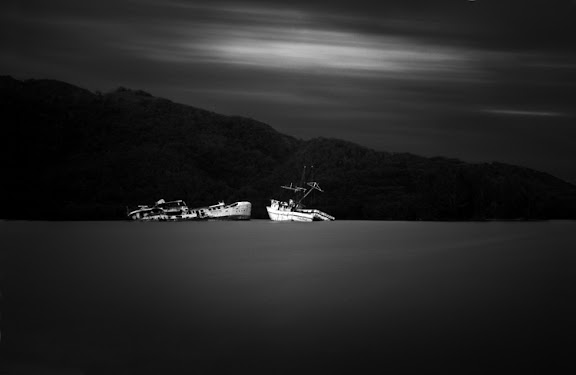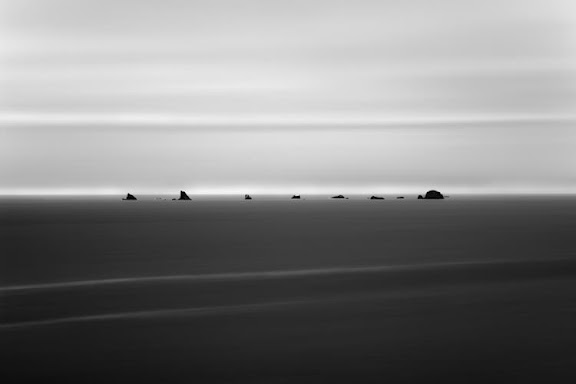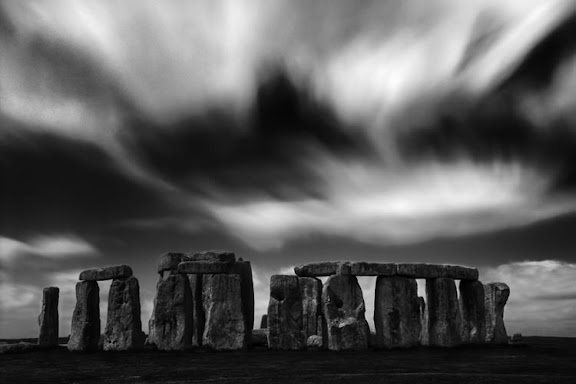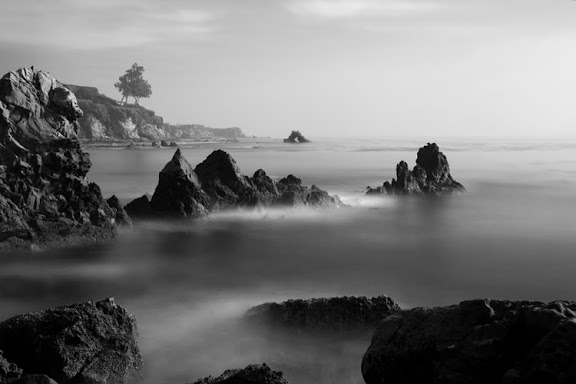Year: 2013
December 27, 2013
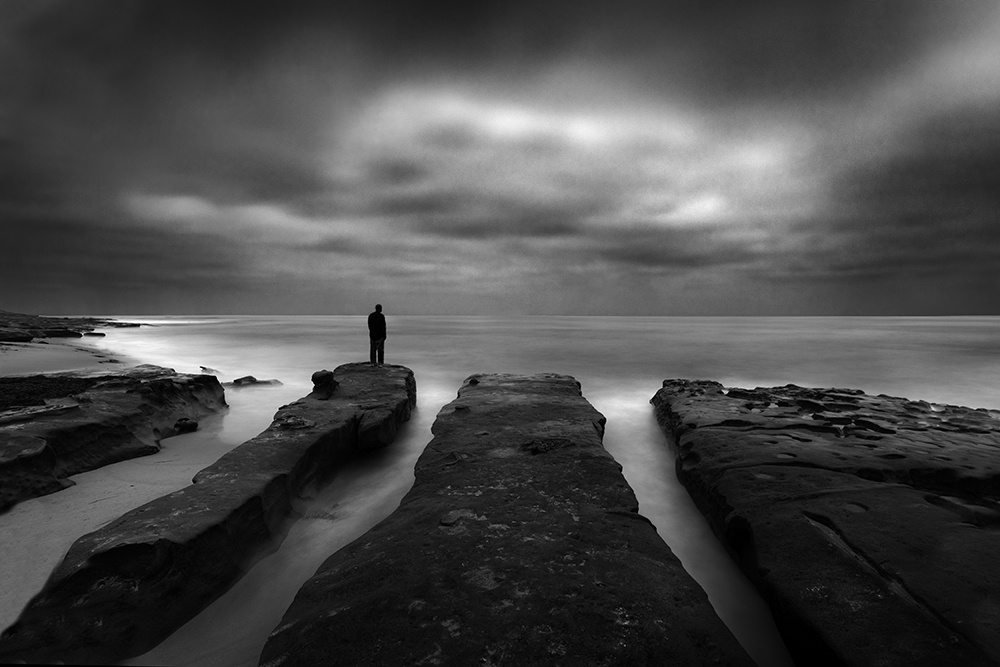
Lone Man No. 20
When I show people my “before and after” images, their reaction tends to be: Wow, how did you do that?
This also tends to be my first reaction when I see an image that I love. Recently a friend showed me his latest creation that was both beautiful and unique, and I wanted to ask him: Benoit, how did you do that?
But I didn’t ask him.
Why not?
Because the miracle of the image was not the technique he used, but the imagination that created the image. Anyone can learn a technique, but not everyone will learn to find and follow their vision.
If I had asked and he had told me his technique…then what? Copy what he had already imagined and created? There is no joy in copying and yet I see technique after technique become the fad of the season and be copied to death.
I also see many who operate under the false belief that technique must be mastered before Vision can be executed. I emphatically reject that theory!
I believe that a great image starts with Vision and then you work hard to develop the required technique. Remember the old saying “necessity is the mother of invention?” It’s true! Once you have a vision of what you want, then you’ll be energized and driven, and you’ll learn whatever is needed to create the image.
However when I see people focusing on technique first, I find they usually never get around to putting that same energy into finding their Vision, and as a result their work is technically perfect and masterfully imitative. Technique alone misses the mark.
So instead of focusing on Photoshop and its hundreds of features or following the latest fad technique, put most of your time and energy into your Vision. I promise you that this approach will yield better images and much more satisfying results.
Technique is not the key to a great image. Vision is.
Cole
December 19, 2013

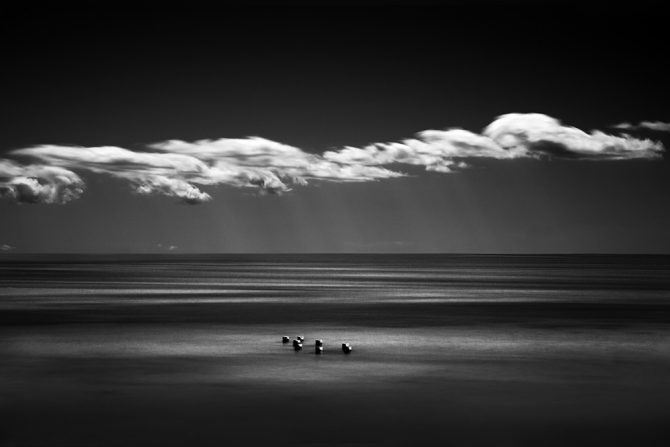
Balance No. 1
I recently taught a workshop on Vision and was discussing my practice of Photographic Celibacy. I explained that the reason I do not look at other photographer’s work is that I don’t want my Vision to be tainted by the vision and images of others. And while that is completely true, there is another reason that I am embarrassed to admit: when I look at other people’s work, I doubt my abilities and get discouraged.
When I see all the many wonderful images out there, I feel mine are inferior by comparison. When I see the great images from locations that I have photographed, I am disappointed that I did not see them. I am overwhelmed by the sheer number of great photographers out there and think: there’s no room left for me. I feel inadequate when I see so many original ideas…that I did not think of.
And so I get depressed at the thought of competing with all of these great images and photographers.
But therein lies my mistake: creating art is not a competition and I should not compare my work to others. I am not trying to be better than someone else, I am trying to better myself.
Everyone has the ability to be great at something, but I cannot be great at all things. I cannot be a a great portrait photographer, a great landscape photographer, a great street photographer, a great floral photographer and a great still life photographer. But there is something I can be great at, and I cannot achieve that greatness by focusing on what I’m not good at. I must recognize my talents and be appreciative for those.
I need to remember that art is not a competition. When I create from my vision there are no losers, only winners.
Cole
P.S. I used to think I was alone in having these feelings, but as I have shared these thoughts with others (including some big name photographers) I’ve learned that many feel the same way. We are all human and share the same frailties, foibles and insecurities. No matter who we are, it seems to be human nature to compare ourselves to others and to sometimes feel inadequate.
December 14, 2013
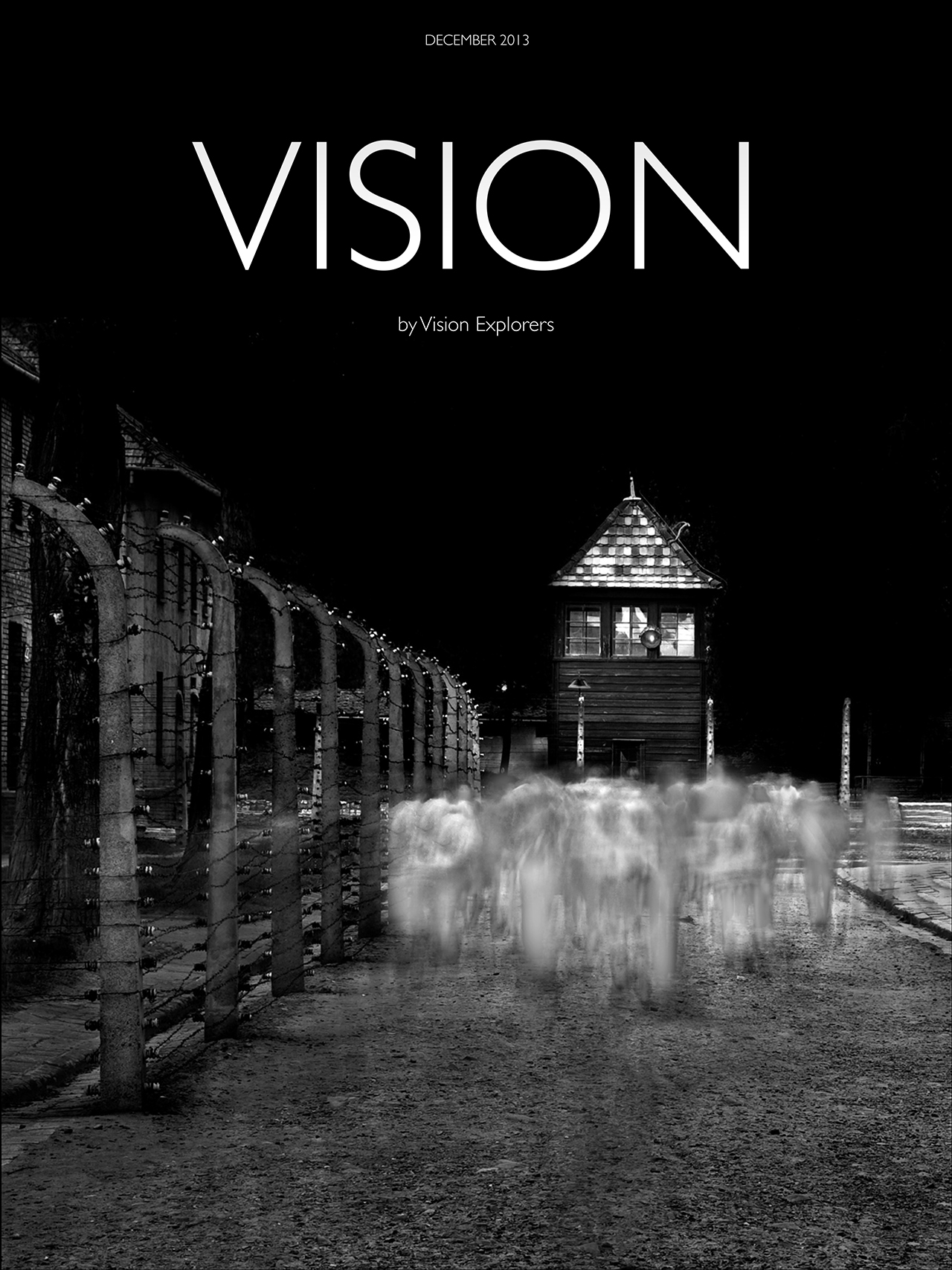

Are you familiar with the new publication Vision? It’s produced by friends of mine: Joel Tjintjelaar, Sharon Tenenbaum, Armand Djicks and Daniel Portal.
What I love about this beautifully simple magazine is that it focuses on Vision rather than equipment, processes and techniques. Here’s a great quote from their website:
“You are an artist before you are a photographer”
Because we share such similar views on vision, they asked to speak with me about the vision that created “The Ghosts of Auschwitz-Birkenau.” The interview is in the December 2013 issue.
Vision is a relevant and important publication for those who seek to improve their creative abilities. Vision is free and you can subscribe here: http://visionexplorers.com/magazine/
You can view and enlarge the individual pages of the article below, or you can View the Entire Article Here




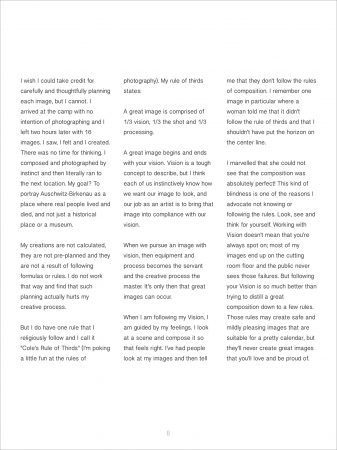
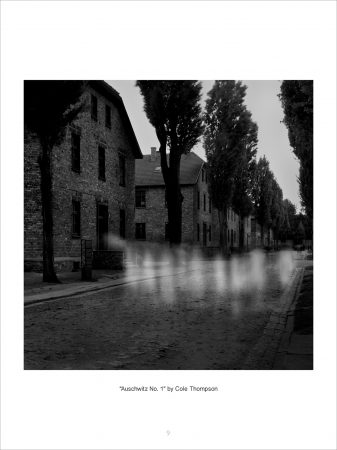
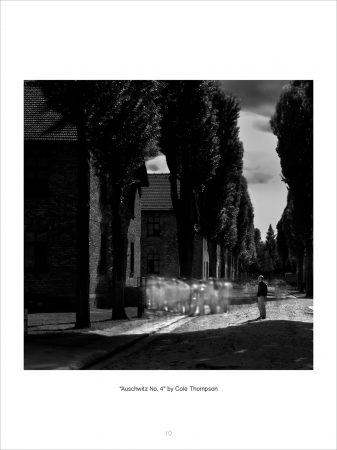
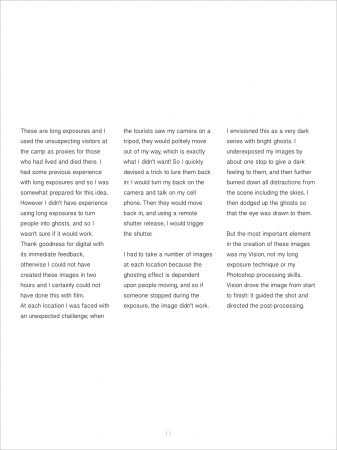
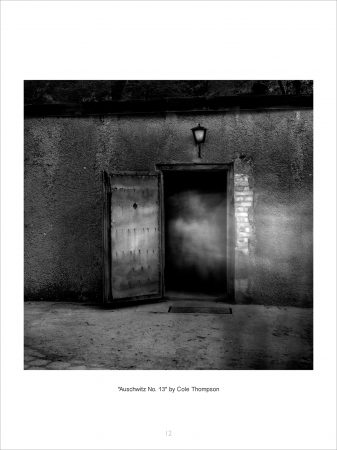
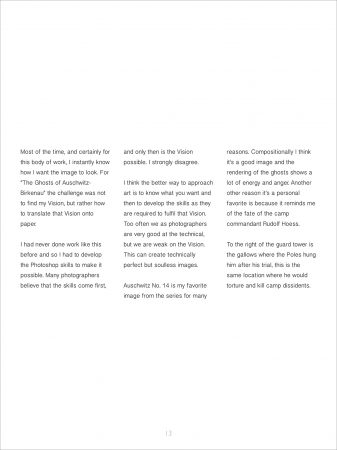

September 26, 2013

Iceland No. 1 – Berufjördður – 2013
Iceland was incredible; the land, the people, the experiences…all of it including a harrowing ride in winds of over 130 mph. My car was severely damaged as flying rocks blew out my windows and sandblasted my car. At the time my only concern was keeping the car upright in the strongest winds I have ever encountered.
But what a great story and memories I now have!
I went to Iceland to create new images, but truthfully if all I came home with are these memories, then the trip was a success. Fortunately, I do think I’ll have a couple images that I like, including “Iceland No. 1” above.
~
On another note, the Death Valley Workshop in January is sold out. Sorry.
But if you’re living in the Colorado area, I am conducting a one day workshop on “Cole’s Rule of Thirds” at the Center for Fine Art Photography. This will be held on Saturday November 9th, 2013 and you can learn more about it at http://www.c4fap.org/education-events/
I’ll also be speaking at Click! Camera Club in Denver on Tuesday, October 1st at 6pm. They will be meeting at Englewood Camera, 5855 S. Broadway in Littleton, Colorado.
Thanks to all for your support!
Cole
August 31, 2013
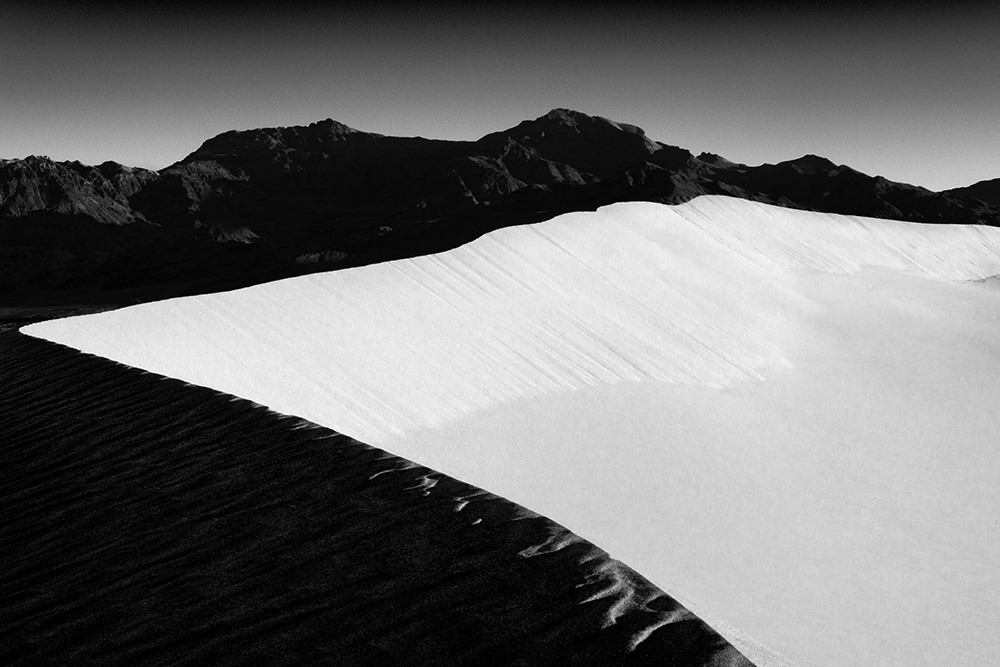
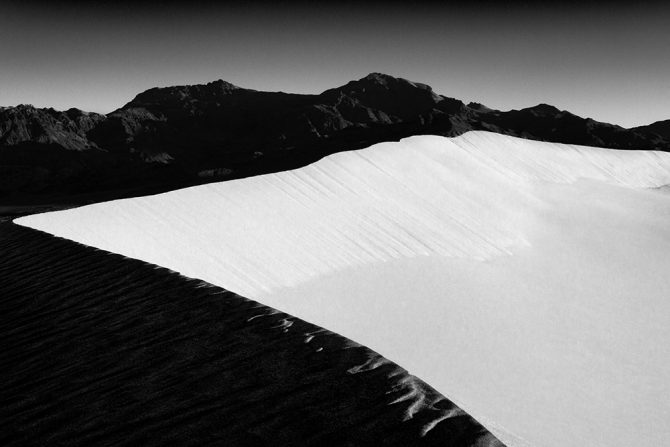
Dunes of Nude No. 89
There are so many times that have people said to me: to be successful you must…
focus on one thing and be known for that
promote yourself
get in a big name gallery
publish a book
be active in social media
get reviewed
be number 1 in SEO
offer small limited editions and high prices
create unique work
etc, etc, etc.
Here’s the problem: how can anyone give relevant advice if they don’t know what my definition of success is?
And more importantly, how can I pursue success if I don’t know what success means to me?
I didn’t ask myself “what is success” until many decades into my career, and what I discovered was that I didn’t like the standard definitions.
I found them to be unfulfilling.
So…take a few minutes and define what you want from your art and what success means to you.
Cole
August 23, 2013


Balance – Split, Croatia
Normally it takes me just minutes to create an image, or perhaps a bit longer if I need to wait for the right conditions. I have a short attention span and if things don’t fall together quickly, I generally lose interest and move on.
However, the image above broke all records and really tested my patience because it took me six hours just to get the shot.
I was walking along one of the popular swimming beaches in Split, Croatia when I saw this scene. Beyond the reach of most swimmers were eight pilings, centered in the bay and protruding just above the surface of the water. I took a few shots and moved on.
The next day I came back and found a better vantage point and set up for another shot. Because I had already photographed the scene and knew what I wanted, I expected to be there for only a few minutes. But just as I was getting ready to click the shutter, a boy swam out to the pilings and sat on them. I thought he’d leave soon and so I waited.
And I waited and waited and waited. I’m not sure what this kid was doing, but I could see him talking and waving his arms in a full-blown conversation with himself.
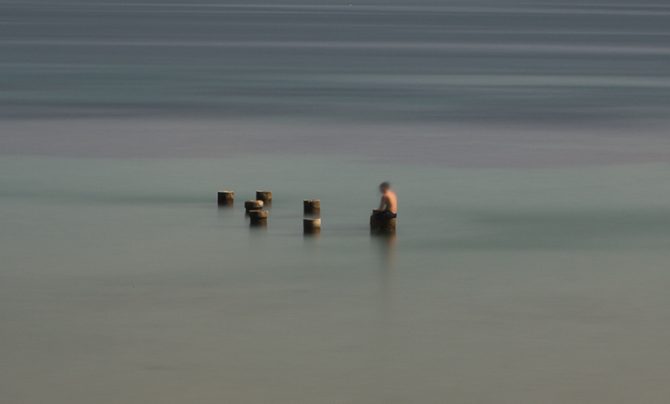
Soon an hour had passed and this kid was still talking! I was starting to get impatient and attempted to do a remote Vulcan mind meld, willing him to leave.

It must have worked because he then slipped into the water. I’m getting all set to make the exposure because I think he’s leaving…but no, he’s gotten back onto the pilings and has continued his conversation.
At this point I’ve got two hours invested into this shot and nothing to show for it, and this kid is still yakking away! I think about leaving, but stay and hope that he’ll run out of things to talk about.
Now three hours have passed and this kid is still out there! In my head I’m screaming “GET OFF THE PILINGS” as he continues to talk to himself.
Finally after about four hours he swims away. Now I can get continue!
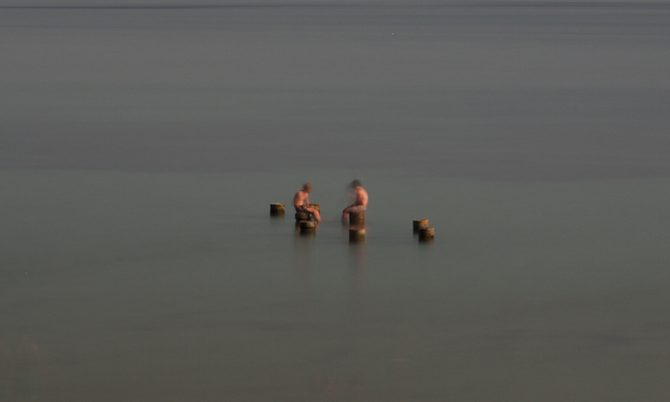
But no, two new people swim out to the pilings. I tell myself that this last kid was an anomaly and that these two will not stay for very long.
Oh, but I be wrong! One hour later and those two are still out there and I can’t believe this. What should I do, leave and cut my losses or protect the time I’ve already invested and wait?
I decide to wait, knowing that with my luck, just as soon as I leave they would too.
It’s now been six hours since I first set up for that “quick shot.” I’m hot, hungry, dehydrated and almost delusional. I’m like Humphrey Bogart’s character in “The Treasure of Sierra Madre,” ranting and talking to myself.
Passer-by’s are staring at me and giving me a wide berth. But there’s no way that I can leave now, it’s a matter of principle, I must get this shot!
Finally the two leave and I am able to create the image “Balance” after six hours of waiting.
What lesson did I learn from those six hours? Wear sunscreen, I really got burnt.
Cole
August 16, 2013
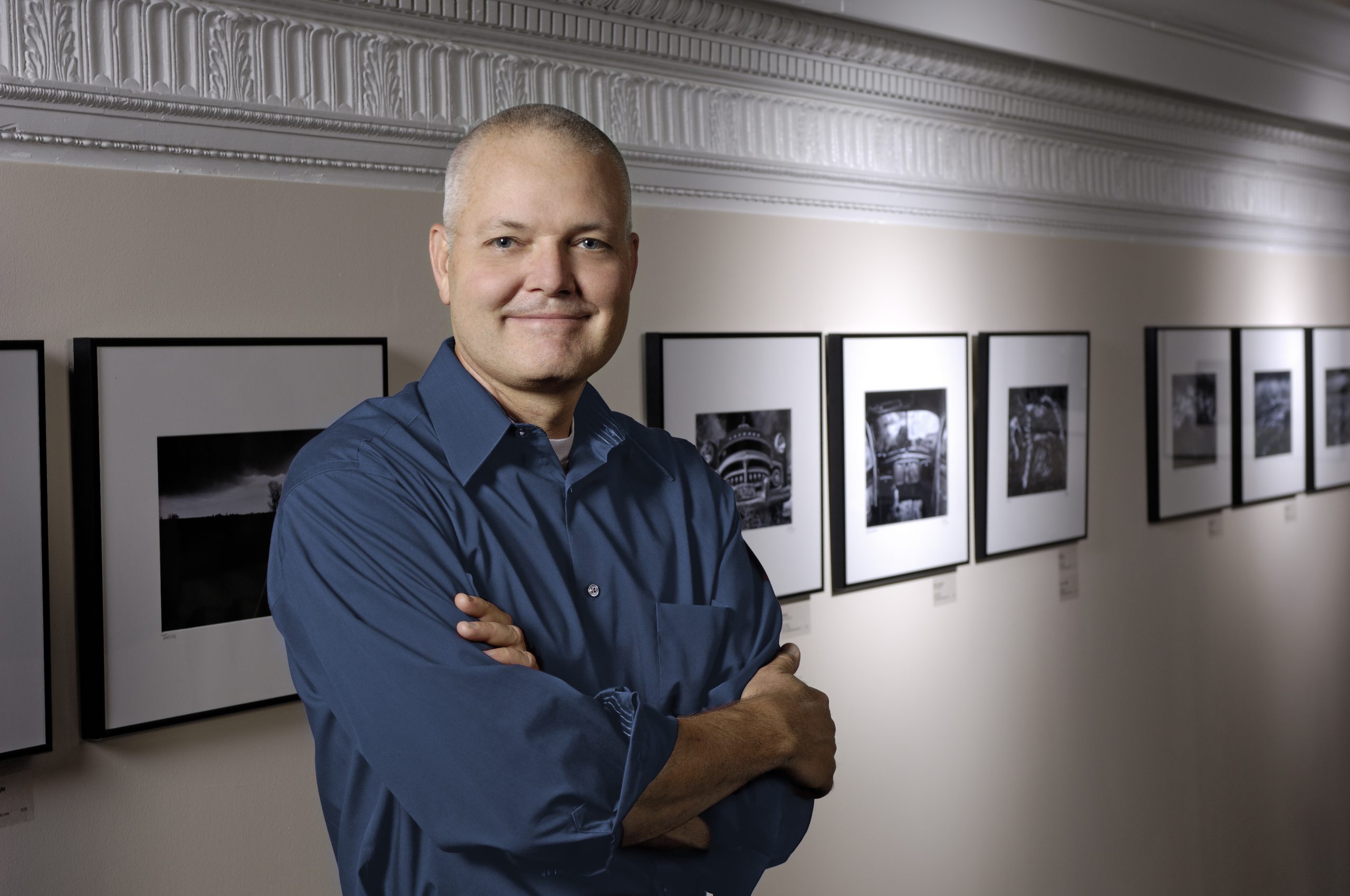

Original Article: http://www.clickinmoms.com/blog/photography-interview-with-fine-art-photographer-cole-thompson/
We love photography interviews and today we are excited to bring you an interview with fine art photographer Cole Thompson. Cole is a brilliant photographer and we are honored to have him here today sharing some of his wisdom with us!
an interview with cole thompson
Can you please touch on your practice of “Photographic Celibacy”? I found this quote on your blog:
“As I analyzed how I was working, I came to the conclusion that when I studied another photographer’s work, I was imprinting their style onto my conscious and subconscious mind. And then when I photographed a scene, I found myself imitating their style rather than seeing it through my own vision. To overcome this tendency I decided to stop looking at the work of other photographer’s, as much as was practically possible.”
This fascinates me! I have been doing a modified version of this for a while. Do you still practice this?
Yes, I have practiced Photographic Celibacy for about 5 years now. What “Photographic Celibacy” means is that I do not look at other photographer’s work. I don’t browse photo books, I don’t look at the images in photo magazines and I don’t seek out other’s work on the internet.
Why don’t I look at the work of others?
Several years ago I attended a portfolio review and during the final interview I showed my work to a gallery owner. He briefly looked at it, brusquely pushed it back to me and said “It looks like you’re trying to imitate Ansel Adams. I replied that I was, because I loved his work! He then said something that would (eventually) change my life.
Ansel’s already done Ansel, what can you show me that demonstrates your vision?
After about two years of wrestling with this I finally had my epiphany: I was never going to do Ansel better than Ansel did Ansel, and so was my goal to be the world’s best Ansel Adams imitator?
Armed with this epiphany, I had this great desire to develop my own Vision, but what exactly was Vision? After a lot of reading and thinking I came to the conclusion that Vision is simply the unique way that I see the world because of my life experiences. I see things differently than others because I’ve had different experiences.
I also concluded that Vision is not developed, but discovered. My vision was already there, created by my life experiences, and what I needed to do was to find and follow it. I was so busy seeing the world through the eyes of other’s images that I was not seeing through my Vision.
I noticed that when I studied the work of others I would then try to recreate their look and sometimes even try to copy some of their specific images! I concluded that to be able to follow my Vision, I needed to stop immersing myself in their Vision.
I knew I couldn’t erase a lifetime of images that were stored in my head, but my theory was that if I stopped focusing on their work, I could more easily find my Vision. And as time went on I found that the influence of those stored images diminished and my Vision came out more and more.
Has it worked? Yes, since pursuing Photographic Celibacy my work is better, more diverse and most importantly, it really is mine. One of the great advantages I’m now enjoying is that when I go to a location to work, such as Iceland this September, I don’t have any idea of what others have done before me and I’ll not be tempted to copy their work.
This idea of Photographic Celibacy is not always well received by others. What I often hear is “I love looking at the work of others and it inspires me.”
I can only speak from my own experience, but focusing on the work of others only inspired me to get out and copy. Additionally, I found that looking at their work caused me to compare myself to others, which is not a positive thing. I would become envious of someone else’s work and skills, which caused me to overlook my own talents and which stunted my growth.
I also found myself jumping from subject to subject and technique to technique as fads came and went. I was like the wheat in the field, blown about with every wind, always following but never leading.
So, will I practice Photographic Celibacy forever? I doubt it, but for right now, it works for me and I enjoy going down my own path rather than following others on theirs.
How do you cultivate your vision?
Here are some of the things I do to stay in touch with my vision:
- I don’t study the work of others.
- I don’t follow the rules of photography. Following rules is the exact opposite of following one’s vision. Over the years I have had people look at my images and tell me that my image didn’t follow the rule of thirds or that I shouldn’t have centered my subject. I just smile and think how grateful I am that I don’t know or follow the rules!
- I set aside “alone time” to create. I’ve tried to work while on family vacations or while out with other photographers, but I just cannot focus on my vision with others around.
- I get away for several days to create. I find it takes me 2-3 days just to get my head clear and to start to “see.”
- I read the Edward Weston Day Books. I love Weston’s images, but I love his attitudes as an artist even more and they put me in the right mood to create.
- I listen to the Beatles. Upon achieving success, artists are then afraid to stray outside of their successful formula. But over time they become stagnant and lose their creative edge because they weren’t growing. What has always impressed me about the Beatles is how they didn’t do that, their music was always changing and pushing new frontiers. Their music reminds me to grow and change with my art.
- I cultivate attitudes that allow me to create unencumbered. An important attitude I cultivate is to not care what others think about my work; I create for myself and I never consider how others will react to it, if they will like it or if it will sell. My only goal is to create art that I love.
- Simplify. I have found that it’s easy for me to fall in love with equipment and processes and not pay enough attention to my Vision. To keep that in check, I have embarked on a program of simplification; I have simplified my equipment and processes to the bare essentials so to minimize distractions.
The term “Fine Art” is a bit of conundrum to me. How do you define this term?
This topic has been on my mind for several years and I’m currently writing a blog entry about it.
How would I define fine art? My short answer is: I wouldn’t. I mean, who cares? There will never be a definition that everyone agrees upon and it really doesn’t matter to me what someone else says anyway. If I love an image and then find out that it’s not considered fine art, do I love it any less?
The only thing that I concern myself with is: Do I like the image and would I hang it on my wall?
I have a friend who looked at one of my images and said: this is not fine art because people don’t smile in fine art.

This image may or may not be fine art, but I don’t think it’s because the girl smiled!
I think each of us defines what fine art is and it doesn’t really matter what anyone else thinks.
What is your photographic belief system? What rules (or lack of them) guide your process from idea to execution?
I do have some principles that I follow:
- I must create from my own vision.
- To create my best work, I must create for myself.
- I never ask others about my work.
- I create because I love to; not to win contests, sell art or to win praise.
- I will keep things simple: my equipment, my processes and my images.
When did your shift from photographer to artist happen? Did you see or feel a change in your images after this realization?
My “conversion” to artist took place after I returned to photography in 2004, after a 35 year absence during which I raised a family and built a business. Upon returning I was fortunate to meet a woman who became my mentor and luckily for me she was an artist who used photography (as opposed to a “photographer”).
She saw my rigid photographic rules as an impediment to my creative growth and over time she helped me to understand that it was okay to be a photographer and to document, but it was also okay to be an artist and to create.
Has my work changed since I achieved this mental shift? Yes, very much so.

This is “The Angel Gabriel” and I consider this to be the first image that I really created as an artist, armed with an awareness of my vision. First let me tell the story of how this image was taken:
This is the Angel Gabriel. I met him on the Newport Beach pier as he was eating French Fries out of a trash can. He was homeless and hungry. I asked him if he would help me with a photograph and in return, I would buy him lunch.
The pier was very crowded and I wanted to take a 30 second exposure so that everyone would disappear except Gabriel. We tried a few shots and then Gabriel wanted to hold his bible. The image worked and the only people you can see besides Gabriel are those “ghosts” who lingered long enough for the camera.
Gabriel and I then went into a restaurant to share a meal; he ordered steak with mushrooms and onions. When it came, he ate it with his hands. I discovered he was Romanian and so am I, so we talked about Romania. He was simple, kind and a pleasure to talk with. I asked Gabriel how I might contact him, in case I sold some of the photographs and wanted to share the money with him.
He said I should give the money to someone who could really use it; that he had everything that he needed. Then the Angel Gabriel walked away, content and carrying his only two possessions: a Bible and a bed roll.
When I asked Gabriel to stand there on that pier, I had an immediate “Vision” of how I wanted that image to look; I could “see” it in my mind’s eye. As a photographer I’m not sure I would have then taken the next step to manipulate the image to match that Vision, but as an artist I was willing to do that.
How has my work changed since I made this mental shift to artist? Most of my past work as a photographer was very traditional landscapes, and now my work has expanded into other areas. It is more conceptual and I’d say “simpler.” I still love landscapes, it’s in my blood, but even those landscapes have changed and become more conceptual.

Swimming Towards the Light
This is an image I never would have been able to create as a photographer because I hadn’t yet found my Vision and I was too bound by rules which limited my thinking.

Harbinger No. 1
Sometimes I find that my new images hearken back to my landscape roots, but are heavily influenced by my new thinking. This is a landscape, but it has been manipulated to match my vision.

Ceiling Lamp, Mourning Dove Ranch
This is a series that I may not have pursued as a photographer. I was standing in a hotel lobby waiting to check out when I looked up and noticed how cool a ceiling lamp looked from directly below. I moved the furniture out of the way, lay on my back and just looked at it with fascination. That was the beginning of the Ceiling Lamp series.

Auschwitz No. 14
“The Ghosts of Auschwitz-Birkenau” series is about as different from my traditional work as I could get. It is a series of ghost images created at Auschwitz-Birkenau.
Has my work changed since I made the mental shift to artist? Yes, and in my opinion for the better. Most importantly I’m happier with my work because I’m forging new ground and the work is truly mine. I am now proud of my images because of how I feel about them, not because of the awards, exhibitions or accolades they have received.
What are your views on photographic manipulation?
When I thought like a photographer the idea of manipulating an image was abhorrent to me, but now when someone asks “do you manipulate your images?” I reply “Yes!” As an artist it is my job to manipulate my images, to bring them into compliance with my vision. I am not documenting a scene, but showing others how I see the world.
As a photographer I used to think that my photographs told “the” truth and now I understand that they really only tell “a” truth. Really, everything I did as photographer manipulated the image; how I framed the shot, the focal length I chose, my exposure, how I cropped the image and how I processed it. Everything I did changed the story that my images told.
Once I came to appreciate this I realized that manipulating my images was not a photographic sin! I was suddenly free to “create” rather than “capture.” This opened up the creative process to me and it was very liberating.
When I look back now, I am mystified at how I could have felt such guilt in manipulating an image!
Are there ways that I personally wouldn’t manipulate an image? Sure, but not because there’s anything wrong with those manipulations, but rather because they don’t fit into my Vision or style.
Not long ago I had someone anonymously write and say that they could tell by the shadows that I had inserted this cloud into my image:

Harbinger No. 1
I was offended, because I had not inserted that cloud!
I had to ask myself why I was so offended at that accusation, regardless if it were true or not. Was it because I still clung to some of my old “photographer ethics” which said such a thing was wrong and I didn’t want anyone to think I had crossed that line?
Each person must decide for themselves what they are comfortable doing and I have long ago stopped judging what others do and just focus on my art.
What advice would you give a photographer that would like to move into the fine art realm?
I’d ask them why they want to get into fine art. If the answer is “to make money” then I’d have a good long laugh and wish them well. But if it’s because they have this burning desire to create work that they love, then I’d give them this advice:
Believe in yourself and have faith in your creative abilities. I was raised in a home with no exposure to art or music and I came away convinced that I was born without a creative gene. That’s part of the reason I pursued photography, I thought that by becoming a great technician I could compensate for my lack of creative abilities. Fortunately I learned that I do have those abilities; that they were simply undiscovered and atrophied from lack of use. I also came away from my experience with a strong conviction that every single person has these creative abilities. Guaranteed!
Find your vision. How do you see the world differently because of your life experiences? It’s a long and hard road to find your vision, mine took two years, but it is essential to create work that you love and are proud of.
Throw away your photographer mentality and let yourself go! Break out of your photographer role; do anything and everything and break all the rules.
Think of yourself as an artist. To help me make this mental shift I stopped saying things like “take a photo” and instead said “create an image.” I called myself an artist and referred to my work as art. At first that was hard for me to do because I felt a fraud, but over time I started believing it and actually became it. These were small things, but they helped remind me of what I wanted to become.
Create out of love and not for money or recognition. I cannot create my best work if my motives are fame or fortune. For this reason I have come to conclude that money and art do not mix.
Be independent. Don’t ask people what they think of your work and don’t care either. Create only to please yourself because at the end of the day, it’s only you, your art and how you feel about it.
Focus on the creative. As important as good equipment and technical skills are, they alone do not create great images. Focus on the creative and use your equipment and technical skills to support your Vision.
Have fun. Creating should be fun and not a job, and not something that must be completed by a certain deadline. Those things are “creativity killers!”
What is your favorite image or series of images in your portfolio and why?
You might as well ask which of my children is my favorite child. That’s impossible for me to answer!
One of my favorites is The Angel Gabriel above, but I have several other favorites:

Flaming Dahlia
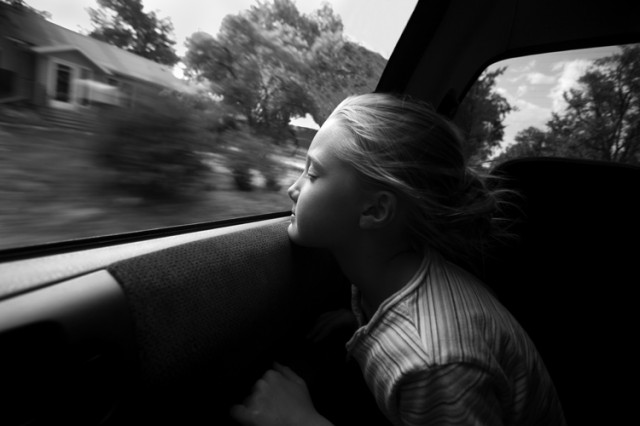
Windsurfing

Auschwitz No. 14

Old Car Interior

Lone Man No. 20

Primordial Soup

Monolith No. 10

John Holland Memorial
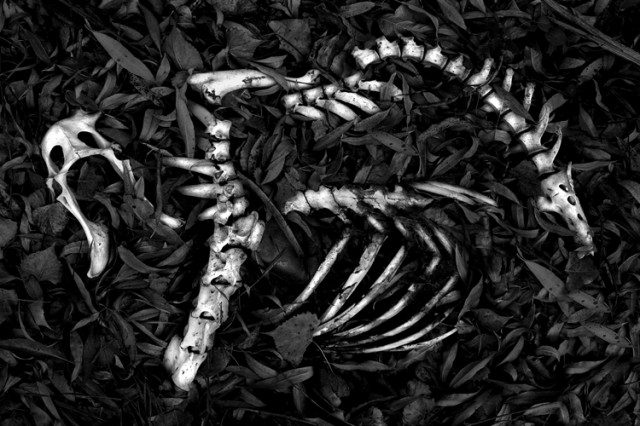
Skeleton

Dunes of Nude No. 43
When you have a vision you want to create, how do you solve the problem of how to do it? For instance, if you want to create a certain look or effect, where do you turn to learn new techniques? Do you learn by experimenting or turn to books or videos?
I am self taught and have never taken a photography class or workshop. I like to learn by doing and experimenting and so when I have a vision of what my image should look like and have reached the end of my technical skills, I simply start trying things. I have always figured something out, and while it may not always be an elegant approach, it works.
Popular Photography called me the “Photoshop Heretic” because I use Photoshop in an unorthodox way. I used to be embarrassed about that, but now realize that it doesn’t matter how you get there, as long as you do get there.
People are surprised to learn that I create most all of my images using only six tools in Photoshop. I have an extremely simple workflow and most of my creative work is done through dodging and burning. You can read more about my workflow here.
Each person has their own way of learning, and mine is “hands on.” Others read the manual, some take a class and others prefer to watch a YouTube video.
One thing I do caution people about is becoming addicted to new processes and techniques. There are certain fads that sweep through the photographic community such as HDR, and then you’ll see everyone doing it. Then it will be shift-tilt, and then long exposures and then something else.
From my experience, Vision does not flow out of fads or techniques but rather it’s the other way around: Vision can drive you to use certain techniques. That’s why I always recommend pursuing the creative first and then learning the skills needed to support that vision.
How important is gear in your work?
“A photographer went to a socialite party in New York. As he entered the front door, the host said ‘I love your pictures – they’re wonderful; you must have a fantastic camera.’ He said nothing until dinner was finished, then:
‘That was a wonderful dinner; you must have a terrific Stove.’” Sam Haskins
For many years I thought I had to have the best equipment and a wide range of technical skills before I could create good images. I reasoned that unless the tools and technical skills were in place, I could not execute my ideas.
But in the end I spent 99% of my time on equipment and processes and neglected the creative. Photography became an expensive hobby as I collected equipment, accessories and learned tons of new processes. The problem was that they became my goal, not a tool to achieve a goal.
I see a lot of photographers who focus on equipment. It is easy to detect this kind of thinking by the questions people ask me when looking at my images. Often times the questions are:
“What camera and lens did you use?”
“What were your settings?”
“Did you use the XYZ plug-in to convert this image to black and white?”
These questions imply that the key to my image’s success was equipment or settings, and if they just could duplicate these, they could create such an image. Wrong mon ami!
What is the role of equipment in the creative process? Let me introduce you to “Cole’s Rule of Thirds.”
Cole’s Rule of Thirds
A great image is comprised of 1/3 vision, 1/3 the shot and 1/3 processing
A great image begins and ends with your vision. Vision is a tough concept to describe, but I think each of us instinctively knows how we want our image to look, and our job as an artist is to bring that image into compliance with our vision.
When we pursue an image with vision, then equipment and process becomes the servant and the creative process is the master. It’s only then that great images can occur.
Vision is everything.
How important is equipment? It’s important but not nearly as important as we’d like to think. If I had to choose between the world’s best camera and no vision, or an old Kodak Brownie accompanied with Vision; I’ll happily take the Brownie.
What has been your biggest photography related challenge?
Getting over myself.
Eliminating my desire to please others.
Wanting and needing validation.
I used to think that if I could please someone else; a critic, a gallery owner or professor, then I would feel good about myself and my work. I believed that if my work was chosen for an exhibition or I had my work published, then birds would sing, the sun would shine and life would be wonderful!
But what I instead found was the accolades were great for a few minutes, but then it was all over. In the morning it was still me, my images and how I felt about them. Receiving the recognition was nice, but it wasn’t a substitute for feeling good about my work.
That’s one of the great benefits of getting older, you start to get over yourself and realize that what you think about your work is much more important than what others think of your work.
You work exclusively in black and white for your art work. Are your personal photos also black and white or do you navigate into color for your personal memories? Do you have trouble letting go of your art in your personal photos?
All of my family photos are shot on an iPhone 5 and in color! On a family vacation, all I want to do is “point and shoot” without any thinking.

Kihei, Hawaii – 2013
What is your definition of success? Have you achieved this?
For many years I pursued the “standard” definition of success: fame, fortune, to be represented in a big-name gallery and to have a book published. For too long I coveted those things without ever stopping to ask if this was “my” definitions of success.
Once I started to achieve those things, they brought about a temporary pleasure, but also an emptiness that left me wondering, is this it? I started to ask what was it that “I” really wanted and it came down to this:
To do what I want and to create work that I love.
And so to a great degree I have achieved success. I create for myself, I love my work (some more than others) and I get to travel to incredible places. Really, what more could I want photographically?
I think it’s also important to note that photography is not my life, it is something that I do that makes my life better.
What is your view of our fast-paced digital world? Do you think that iPhoneography or similar is a benefit or a detriment to the photographic artist?
I think iPhoneography is just another tool and if it’s useful to serve your vision, then it’s a good thing. Let me tell a story that just happened to me.
I was in St. Petersburg, Russia photographing some trees at Peterhof. While there I also pulled out my iPhone and took a picture for the family album (I am the designated picture taker in our family). When I got home and began processing the trees, I didn’t find a single image that I liked. Disappointed and about to give up, I remembered that single image I took with my iPhone.
Compositionally, the iPhone image worked but I doubted that it could be printed to any reasonable size since it was shot with an iPhone and then severely cropped into a panorama. But I was pleasantly surprised when I printed it at 15 inches wide and it looked great!

Peterhof
Should I not take this image as seriously as my others, simply because it was created on an iPhone? My personal philosophy is: all that matters is the image and do I like it?
Cameras, lenses and all the rest are simply tools. It’s vision, imagination and breaking the rules that creates great images.
Regarding the larger question of digital versus the old ways; I lived with those old ways for many years (I started in the darkroom in 1968) and I have to tell you that while I have some fond memories, I would never go back. I love the digital world and my work has never looked better.
Thank you Cole for spending some time with us today and sharing your insights with us!
Would you like to see even more of Cole’s wonderful photography? Make sure you visit his website, blog, and facebook to view his images. Don’t forget to also follow him on twitter and pinterest!
August 13, 2013
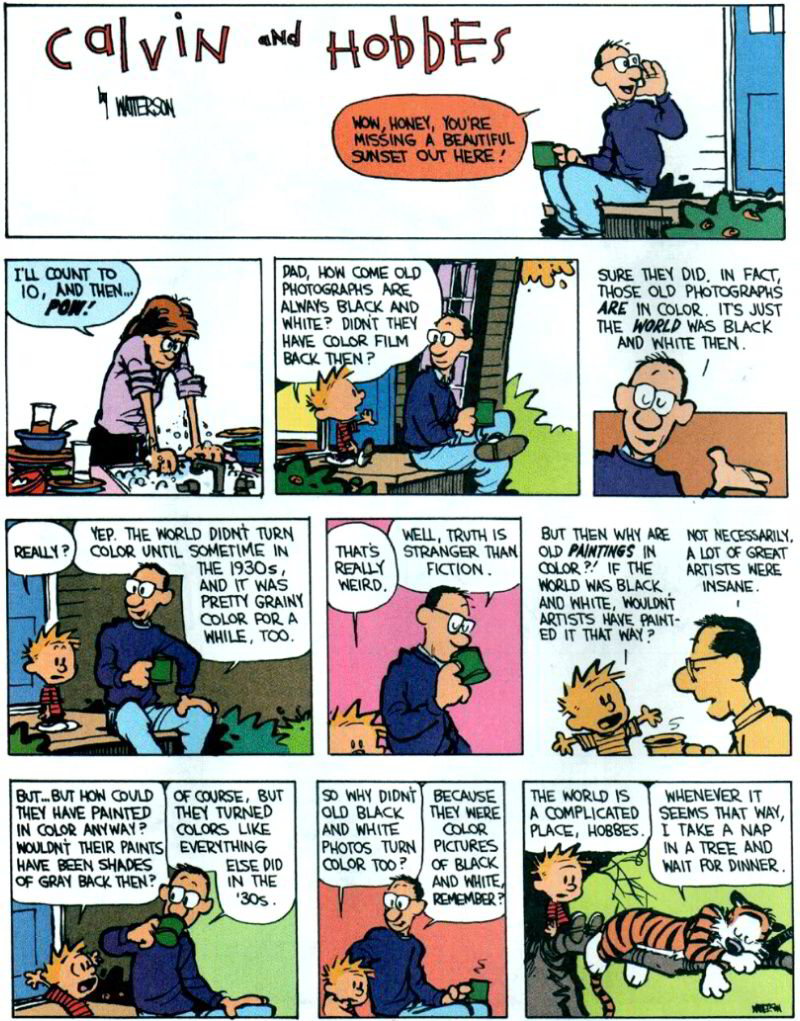

July 23, 2013
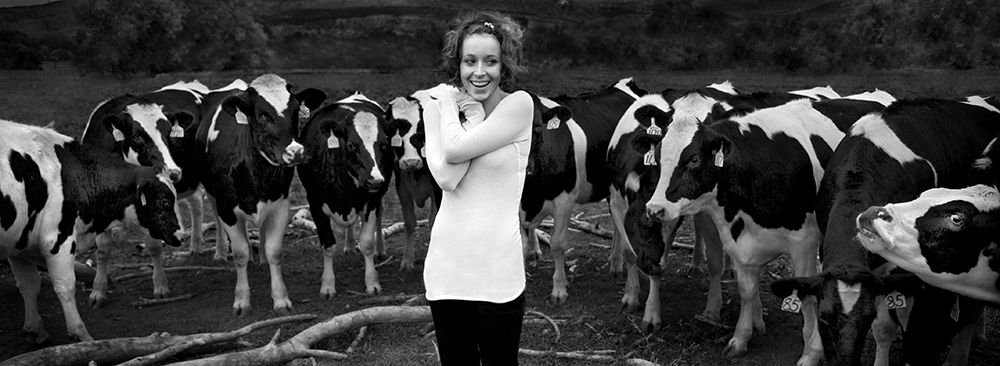
How would I define art or fine art? My short answer is: I wouldn’t.
I mean, who cares? There will never be a definition that everyone agrees upon and it doesn’t matter to me what someone else thinks about it anyway. If I love an image and then find out that it’s not considered fine art, do I love it any less?
The only thing that I concern myself with is this: Do I love the image and would I hang it on my wall?
I have a friend who looked at my image above and said: “this is not fine art because people don’t smile in fine art.” This image may or may not be fine art but I don’t think it has anything to do with the girl smiling!
Another friend told me that work created for money cannot be fine art. I’m not sure what a person’s motives have to do with it, shouldn’t it be about the image?
I choose not concern myself with such distractions. I simply know if I like something or I don’t and I figure that if I’m creating the piece, then my opinion is the only one that counts.
P.S. For those who know me a bit might ask why the seeming inconsistency between my rhetoric above and my actions? Three examples:
1. Go to Google and type in “B&W Fine Art Photography” and see what you get. I’ve worked hard to be on the first page.
2. If you were to overhear someone ask me “what do you do?” you’d then hear me say “I’m a fine art photographer.”
3. I was president of board for “The Center for Fine Art Photography.”
Despite how I might feel about defining “fine art” there is reality: we use words to describe things.
I target the term fine art with Google because that’s the phrase people use when they are searching for my type of images.
In the past when I told people that I was a photographer, I’d then spend the next 10 minutes explaining that I don’t do portraits, weddings or Bar Mitzvah’s.
And believe me, we have agonized over the term “fine art” over at the “Center” and wish we could find a better one.
The reality is that when I use the phrase “fine art photography” people generally know what I’m talking about. This is why I hate the term, but also use it.
July 9, 2013
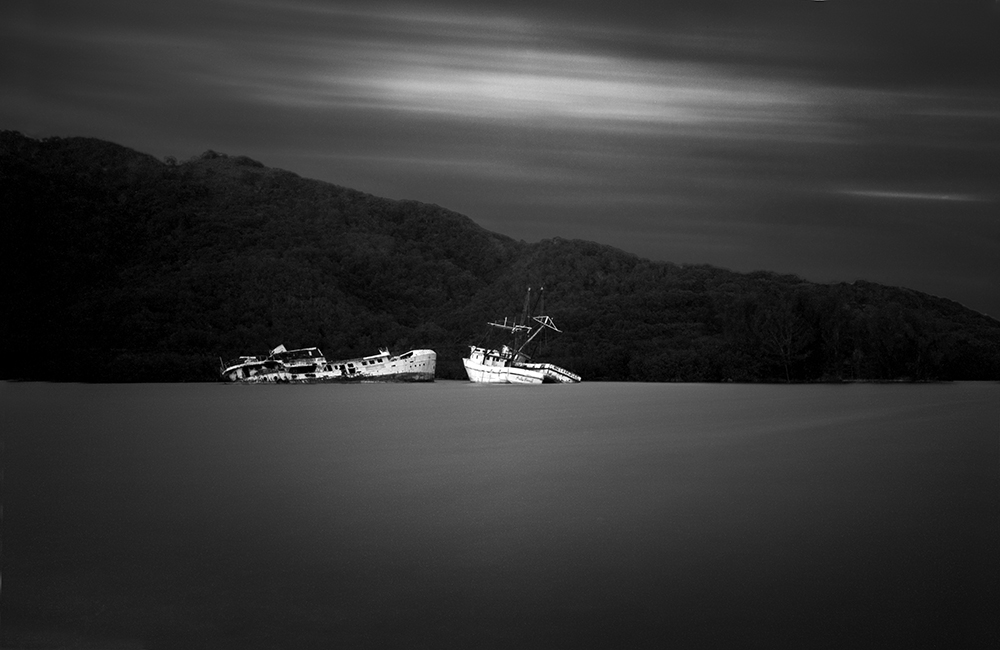
Tech Report: Cole Thompson explains how to determine correct exposures for long exposure images
An acknowledged master of long-exposure photography, Cole Thompson shares his techniques for finding his “correct” exposure, and extrapolating that to dramatically longer exposure times.
| Balance – Split, Croatia – 2013 (2 minute exposure) |
Getting the correct exposure when using one or more neutral density filters can be challenging. I use up to 18 stops of ND with exposures ranging from 30 seconds to 8 minutes. At first finding the correct exposure was very frustrating and my images were often underexposed and I’d have to resort to guessing at the correct exposure, which often meant I missed the shot.
| Miss Danielle – Guanaja, Honduras – 2010 (4 minute exposure) |
It took a while to figure everything out, but now I have a very simple system for setting the correct exposure and it usually works right the first time. Most of it is straightforward, but there are a couple of “secrets” that could make your long exposures a bit easier.
| Lake Erie – Cleveland, Ohio – 2013 (1 minute exposure) |
I use a Canon 5D digital camera for most of my work. While I could use a film camera, getting the right exposure would take much longer because film doesn’t have the immediate feedback that’s provided by a digital camera. I mention that I use Canon because one of my “secrets” applies only to Canon cameras.
| Honduran with Plastic Rake – Guanaja, Honduras – 2010 (30 second exposure) |
Let me give you an idea of how much 18 stops of neutral density is. If my correct exposure for a scene on a sunny day is 1/500 at f8, then using 18 stops of ND would allow me to shoot a 4 minute exposure with that same sunny scene! That is a lot of light reduction and that means only a tiny fraction of the light is making it through the filters and onto the sensor.
But even with this small amount of light, the camera’s meter is up to the task! I have never needed to use a handheld light meter or long-exposure calculator.
To start off I set my ISO to 50 (typically the lowest ISO available on a digital camera) and set my shutter speed to 30 seconds (typically the longest exposure setting on a digital camera) and then take a meter reading of the scene.
And now for my first and most important secret:
 Secret number 1: To get a correct exposure reading at these low light levels I must completely seal off the viewfinder so that no light enters the camera from the rear.
Secret number 1: To get a correct exposure reading at these low light levels I must completely seal off the viewfinder so that no light enters the camera from the rear.
At these low light levels even the smallest amount of light entering the camera from the viewfinder will give an incorrect exposure reading. How do I seal off the eyepiece? I use an eyecup, such as this one offered by the Hoodman Corporation (see photo).
When using the eyecup I take extreme care to seal my eye completely so that no light enters the viewfinder, otherwise my image will be underexposed.
Once the eyecup is sealed, I simply match my exposure needles for a “correct” exposure and I’m all set for a perfect 30 second exposure.
Now what if I want to use a longer exposure, say 1 minute? How can I calculate my exposure for 1 minute when my camera will only meter to 30 seconds? Simple!
I do everything the same as I did for the 30 second exposure, but now I set the exposure needles to under-expose by 1 f-stop so that my meter looks like this:
Now I switch my camera to Bulb mode and I expose for 60 seconds.
What did I just do here? By using the exposure compensation scale, I underexposed by 1 stop when I metered and then I made up for it by doubling my exposure time.
What is Bulb mode? In Bulb mode the shutter stays open as long as you hold down the shutter. It’s not practical for me to hold the shutter button for one minute because it would shake the camera, so I use a remote switch that allows me to lock the shutter button down for the duration of my exposure. You can use your camera’s official “branded” shutter lock, but there are “off brand” ones available at a fraction of the cost that do the job just fine.
| Monolith No. 27 – Oregon Coast – 2010 (5 minute exposure) |
Now for secret number 2 for Canon users: When I first used this approach, the images would sometimes turn out okay and sometimes they’d be very dark. I couldn’t figure out what was causing my calculation to be so far off. Was it some sort of reciprocity failure, a phenomenon we experienced in the old days of film that required extra exposure time beyond what the meter said? Or was it something else?
My research found nothing on reciprocity failure for digital cameras. And then one day I accidentally discovered why my longer exposures were not working out the way they were supposed to. This is due to a quirky feature of Canon cameras.
When I metered and set my aperture to f8 in Manual mode, I expected the aperture to still be at f8 when I switched to Bulb mode. It was not. It was set at f22 and that explained why my images were grossly underexposed. The aperture setting does not carry over from Manual mode into Bulb mode; you must manually set it each time.
So secret #2 is to be sure that I reset my aperture once I switch to Bulb mode, every time!
So how do I determine the correct exposure for a 2 minute exposure? I do everything the same again, except I set my meter to underexpose by two stops. My meter now looks like this:
I then switch to Bulb, re-set my aperture and expose for 2 minutes.
And for a 4 minute exposure I set my meter to underexpose by 3 stops so that my meter now looks like this:
I switch to Bulb mode, change my aperture and expose for 4 minutes.
What I am doing with this approach is to underexpose when metering, and then I compensate by increasing my exposure time. For every 1 stop I underexpose, I double my exposure time.
Here are the settings to remember:
| Meter for a 30 second exposure, and then adjust as follows: | |
| Meter for correct exposure | 30 second exposure |
| -1 stop underexposed | 1 minute exposure |
| -2 stop underexposed | 2 minute exposure |
| -3 stop underexposed | 4 minute exposure |
At first this system seemed complex, but once I used it a few times it was very easy to remember.
| Ancient Stones No. 2 – Joshua Tree, CA – 2012 (5.5 minute exposure) |
When I’m going to use a very long exposure (over 30 seconds) I’ll start off by first exposing at 30 seconds to check the exposure and composition. If everything looks good, then I’ll expose at the longer exposure time. This saves a lot of wasted time when I’m doing a four minute exposure and then I discover that something wasn’t right!
| Wedding Day – La Jolla, CA – 2013 (20 second exposure) |
When I’m using a 30-second exposure, the camera times the exposure for me. But my camera doesn’t time for over 30 seconds and I must time these exposures myself. At first I used my wristwatch, but I frequently forgot where I started from and I wasted the exposure. So now I use my iPhone timer because I always have it with me, and because I cannot ignore that obnoxious Marimba alarm! There are also various smartphone apps that can help time your exposure, some are free, others cost a couple dollars.
| Stonehenge – England – 2009 (90 second exposure) |
To create my long exposures images I use a Singh-Ray Vari-ND filter and stack a second 5-stop or 10-stop Mor-Slo fixed ND filter on top of that. There are two reasons why I use the Vari-ND.
First, I can open up the Vari-ND filter for easier composing. At 18 stops it’s almost impossible to see anything even after my eyes have adjusted. With the Vari-ND I can allow more light to enter the viewfinder so that I can compose the image, and then I stop down for the exposure.
The second Vari-ND advantage is that I can use the variable feature of the filter to adjust my exposure instead of using the aperture. This allows me to set my aperture to where I want it, to control my depth of field.
Both of these advantages are significant and I always use a Vari-ND when shooting long exposures.
| Little Corona – Corona del Mar, CA – 2010 (3 minute exposure) |
Conclusion: Setting the correct exposure for long exposure photography is pretty easy, it’s all based on accurately metering at 30 seconds and extrapolating from there. Using an eyecup is a must to seal out any extraneous light and the Vari-ND makes composing easy and offers me more control over the scene.
Use the links below to check out Cole’s website, blog, and social media for more information and news updates.

